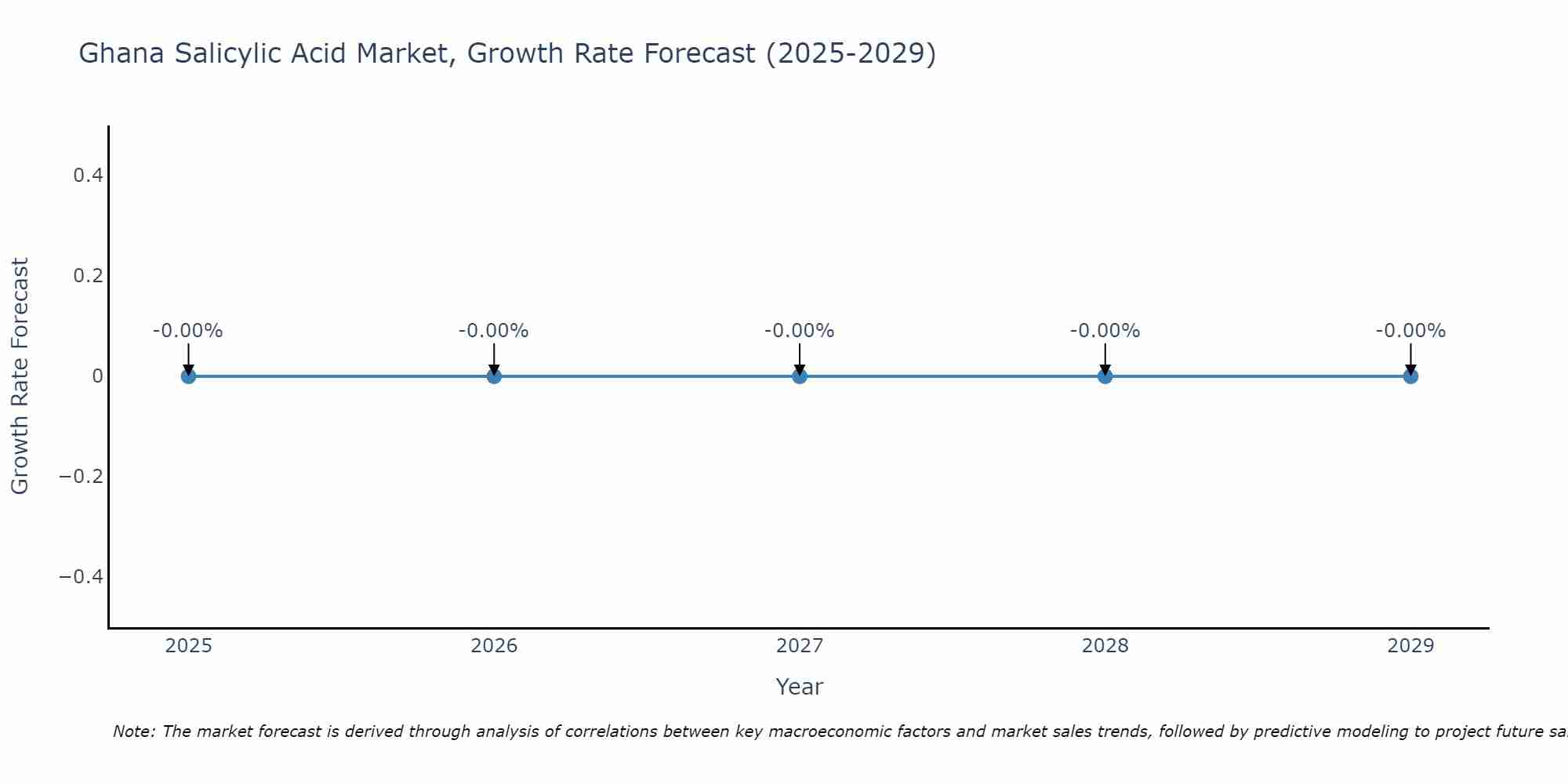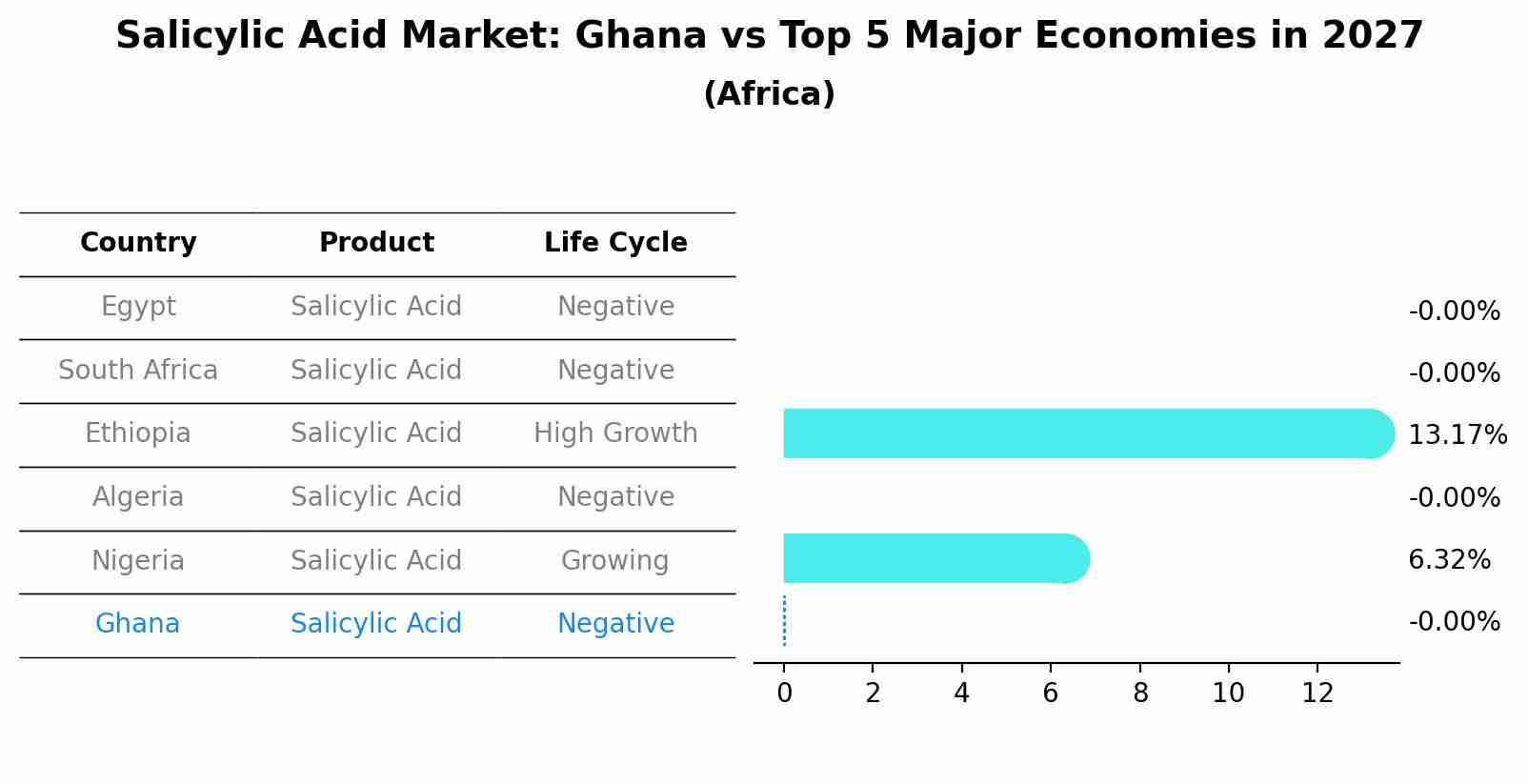Ghana Salicylic Acid Market (2025-2031) Outlook | Size, Share, Companies, Value, Industry, Growth, Revenue, Trends, Forecast & Analysis
| Product Code: ETC102375 | Publication Date: Jun 2021 | Updated Date: Jun 2025 | Product Type: Report | |
| Publisher: 6Wresearch | Author: Ravi Bhandari | No. of Pages: 70 | No. of Figures: 35 | No. of Tables: 5 |
Ghana Salicylic Acid Market Size Growth Rate
The Ghana Salicylic Acid Market is projected to witness mixed growth rate patterns during 2025 to 2029. Growth accelerates to -0.00% in 2026, following an initial rate of -0.00%, before easing to -0.00% at the end of the period.

Salicylic Acid Market: Ghana vs Top 5 Major Economies in 2027 (Africa)
The Salicylic Acid market in Ghana is projected to grow at a negative growth rate of -0.00% by 2027, highlighting the country's increasing focus on advanced technologies within the Africa region, where Egypt holds the dominant position, followed closely by South Africa, Ethiopia, Algeria and Nigeria, shaping overall regional demand.

Ghana Salicylic Acid Market Overview
The Ghana salicylic acid market is experiencing steady growth due to increasing demand from the pharmaceutical, cosmetic, and personal care industries. Salicylic acid is a key ingredient in skincare products for its anti-inflammatory and exfoliating properties, driving its popularity among consumers. The market is also benefiting from rising awareness about skincare and beauty products, leading to higher consumption of salicylic acid-based products. Additionally, the pharmaceutical sector is utilizing salicylic acid in various medications, further boosting market growth. Local manufacturers and distributors are actively expanding their product offerings to cater to the growing demand, and collaborations with international suppliers are enhancing market competitiveness. Overall, the Ghana salicylic acid market is poised for continued expansion in the foreseeable future.
Ghana Salicylic Acid Market Trends
The Ghana salicylic acid market is experiencing growth due to the rising demand for skincare and haircare products containing this ingredient. Salicylic acid is known for its acne-fighting and exfoliating properties, making it a popular choice among consumers looking to address skin issues such as acne, blemishes, and dullness. The market is also benefiting from the increasing awareness about the benefits of salicylic acid in treating various skin conditions. Key players in the Ghanaian market are focusing on product innovation, packaging, and marketing strategies to attract a larger consumer base. Additionally, the trend towards natural and organic skincare products is influencing the market, leading to the introduction of salicylic acid derived from natural sources to cater to the growing demand for clean beauty products.
Ghana Salicylic Acid Market Challenges
In the Ghana Salicylic Acid Market, some of the key challenges faced include limited awareness and knowledge about the benefits of salicylic acid among consumers, which may hinder its adoption in various skincare products. Additionally, the availability of counterfeit or low-quality salicylic acid products in the market poses a threat to the reputation of genuine brands and may lead to consumer distrust. Regulatory hurdles related to product registration and compliance with quality standards also present challenges for manufacturers and importers. Furthermore, the fluctuation in raw material prices and foreign exchange rates can impact production costs and pricing strategies in the market. Overall, overcoming these challenges will require effective marketing strategies, quality control measures, and regulatory compliance to establish a strong foothold in the Ghana Salicylic Acid Market.
Ghana Salicylic Acid Market Investment Opportunities
The Ghana Salicylic Acid Market presents several investment opportunities due to the increasing demand for skincare and pharmaceutical products. With a growing awareness of personal care and hygiene, the market for salicylic acid-based products such as acne treatments, anti-aging creams, and hair care products is expanding. Investing in local manufacturers of salicylic acid or companies that incorporate this ingredient into their product lines could be lucrative. Additionally, there is potential for partnerships with international suppliers to meet the rising demand for salicylic acid in Ghana. This market trend offers investors the chance to capitalize on the growing consumer interest in skincare and pharmaceutical products, making it a promising area for investment in the country.
Ghana Salicylic Acid Market Government Policy
The Ghanaian government has implemented policies to regulate the Salicylic Acid market, with a focus on promoting local production and reducing dependency on imports. Policies include providing incentives for local manufacturers, such as tax breaks and subsidies, to encourage domestic production. Additionally, there are regulations in place to ensure product quality and safety standards are met, in line with international guidelines. The government also aims to promote export opportunities for locally produced Salicylic Acid to boost the country`s economy and create job opportunities. Overall, these policies indicate a commitment to developing and supporting the Salicylic Acid market in Ghana while ensuring compliance with regulations and standards.
Ghana Salicylic Acid Market Future Outlook
The Ghana Salicylic Acid market is expected to experience steady growth in the coming years due to increasing demand in the pharmaceutical and personal care industries. Factors such as rising disposable income, growing awareness about skincare, and the prevalence of skin conditions like acne are driving the market growth. Additionally, the expanding cosmetics sector and the trend towards natural and organic products are creating opportunities for the salicylic acid market in Ghana. With a focus on product innovation and sustainability, key players in the market are likely to invest in research and development to meet the evolving consumer preferences. Overall, the Ghana Salicylic Acid market is poised for positive growth prospects in the foreseeable future.
Key Highlights of the Report:
- Ghana Salicylic Acid Market Outlook
- Market Size of Ghana Salicylic Acid Market, 2021
- Forecast of Ghana Salicylic Acid Market, 2031
- Historical Data and Forecast of Ghana Salicylic Acid Revenues & Volume for the Period 2021 - 2031
- Ghana Salicylic Acid Market Trend Evolution
- Ghana Salicylic Acid Market Drivers and Challenges
- Ghana Salicylic Acid Price Trends
- Ghana Salicylic Acid Porter's Five Forces
- Ghana Salicylic Acid Industry Life Cycle
- Historical Data and Forecast of Ghana Salicylic Acid Market Revenues & Volume By Application for the Period 2021 - 2031
- Historical Data and Forecast of Ghana Salicylic Acid Market Revenues & Volume By Pharmaceutical for the Period 2021 - 2031
- Historical Data and Forecast of Ghana Salicylic Acid Market Revenues & Volume By Food & Preservatives for the Period 2021 - 2031
- Historical Data and Forecast of Ghana Salicylic Acid Market Revenues & Volume By Cosmetics for the Period 2021 - 2031
- Historical Data and Forecast of Ghana Salicylic Acid Market Revenues & Volume By Others for the Period 2021 - 2031
- Ghana Salicylic Acid Import Export Trade Statistics
- Market Opportunity Assessment By Application
- Ghana Salicylic Acid Top Companies Market Share
- Ghana Salicylic Acid Competitive Benchmarking By Technical and Operational Parameters
- Ghana Salicylic Acid Company Profiles
- Ghana Salicylic Acid Key Strategic Recommendations
Frequently Asked Questions About the Market Study (FAQs):
1 Executive Summary |
2 Introduction |
2.1 Key Highlights of the Report |
2.2 Report Description |
2.3 Market Scope & Segmentation |
2.4 Research Methodology |
2.5 Assumptions |
3 Ghana Salicylic Acid Market Overview |
3.1 Ghana Country Macro Economic Indicators |
3.2 Ghana Salicylic Acid Market Revenues & Volume, 2021 & 2031F |
3.3 Ghana Salicylic Acid Market - Industry Life Cycle |
3.4 Ghana Salicylic Acid Market - Porter's Five Forces |
3.5 Ghana Salicylic Acid Market Revenues & Volume Share, By Form, 2021 & 2031F |
4 Ghana Salicylic Acid Market Dynamics |
4.1 Impact Analysis |
4.2 Market Drivers |
4.3 Market Restraints |
5 Ghana Salicylic Acid Market Trends |
6 Ghana Salicylic Acid Market, By Types |
6.1 Ghana Salicylic Acid Market, By Application |
6.1.1 Overview and Analysis |
6.1.2 Ghana Salicylic Acid Market Revenues & Volume, By Application, 2018 - 2027F |
6.1.3 Ghana Salicylic Acid Market Revenues & Volume, By Pharmaceutical, 2018 - 2027F |
6.1.4 Ghana Salicylic Acid Market Revenues & Volume, By Food & Preservatives, 2018 - 2027F |
6.1.5 Ghana Salicylic Acid Market Revenues & Volume, By Cosmetics, 2018 - 2027F |
6.1.6 Ghana Salicylic Acid Market Revenues & Volume, By Others, 2018 - 2027F |
7 Ghana Salicylic Acid Market Import-Export Trade Statistics |
7.1 Ghana Salicylic Acid Market Export to Major Countries |
7.2 Ghana Salicylic Acid Market Imports from Major Countries |
8 Ghana Salicylic Acid Market Key Performance Indicators |
9 Ghana Salicylic Acid Market - Opportunity Assessment |
9.1 Ghana Salicylic Acid Market Opportunity Assessment, By Application, 2021 & 2031F |
10 Ghana Salicylic Acid Market - Competitive Landscape |
10.1 Ghana Salicylic Acid Market Revenue Share, By Companies, 2021 |
10.2 Ghana Salicylic Acid Market Competitive Benchmarking, By Operating and Technical Parameters |
11 Company Profiles |
12 Recommendations |
13 Disclaimer |
- Single User License$ 1,995
- Department License$ 2,400
- Site License$ 3,120
- Global License$ 3,795
Search
Thought Leadership and Analyst Meet
Our Clients
Related Reports
- Afghanistan Apparel Market (2026-2032) | Growth, Outlook, Industry, Segmentation, Forecast, Size, Companies, Trends, Value, Share, Analysis & Revenue
- Canada Oil and Gas Market (2026-2032) | Share, Segmentation, Value, Industry, Trends, Forecast, Analysis, Size & Revenue, Growth, Competitive Landscape, Outlook, Companies
- Germany Breakfast Food Market (2026-2032) | Industry, Share, Growth, Size, Companies, Value, Analysis, Revenue, Trends, Forecast & Outlook
- Australia Briquette Market (2025-2031) | Growth, Size, Revenue, Forecast, Analysis, Trends, Value, Share, Industry & Companies
- Vietnam System Integrator Market (2025-2031) | Size, Companies, Analysis, Industry, Value, Forecast, Growth, Trends, Revenue & Share
- ASEAN and Thailand Brain Health Supplements Market (2025-2031) | Strategy, Consumer Insights, Analysis, Investment Trends, Opportunities, Growth, Size, Share, Industry, Revenue, Segments, Value, Segmentation, Supply, Forecast, Restraints, Outlook, Competition, Drivers, Trends, Demand, Pricing Analysis, Competitive, Strategic Insights, Companies, Challenges
- ASEAN Bearings Market (2025-2031) | Strategy, Consumer Insights, Analysis, Investment Trends, Opportunities, Growth, Size, Share, Industry, Revenue, Segments, Value, Segmentation, Supply, Forecast, Restraints, Outlook, Competition, Drivers, Trends, Demand, Pricing Analysis, Competitive, Strategic Insights, Companies, Challenges
- Europe Flooring Market (2025-2031) | Outlook, Share, Industry, Trends, Forecast, Companies, Revenue, Size, Analysis, Growth & Value
- Saudi Arabia Manlift Market (2025-2031) | Outlook, Size, Growth, Trends, Companies, Industry, Revenue, Value, Share, Forecast & Analysis
- Uganda Excavator, Crane, and Wheel Loaders Market (2025-2031) | Strategy, Consumer Insights, Analysis, Investment Trends, Opportunities, Growth, Size, Share, Industry, Revenue, Segments, Value, Segmentation, Supply, Forecast, Restraints, Outlook, Competition, Drivers, Trends, Demand, Pricing Analysis, Competitive, Strategic Insights, Companies, Challenges
Industry Events and Analyst Meet
Whitepaper
- Middle East & Africa Commercial Security Market Click here to view more.
- Middle East & Africa Fire Safety Systems & Equipment Market Click here to view more.
- GCC Drone Market Click here to view more.
- Middle East Lighting Fixture Market Click here to view more.
- GCC Physical & Perimeter Security Market Click here to view more.
6WResearch In News
- Doha a strategic location for EV manufacturing hub: IPA Qatar
- Demand for luxury TVs surging in the GCC, says Samsung
- Empowering Growth: The Thriving Journey of Bangladesh’s Cable Industry
- Demand for luxury TVs surging in the GCC, says Samsung
- Video call with a traditional healer? Once unthinkable, it’s now common in South Africa
- Intelligent Buildings To Smooth GCC’s Path To Net Zero


















